Nov 08, 2025
Nov 08, 2025
by Aniket Kumar
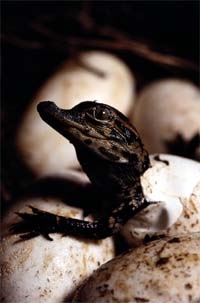 Alligator
Alligator
Whether an alligator is a male or female is determined by the temperature of the nest where the egg is hatched – 90 to 93 degrees will make it a male; 82 to 86 degrees will turn it into a female.
The Kodiak, which is native to Alaska, is the largest bear and can measure up to eight feet and weigh as much as 1,700 pounds.
The fire-bellied toad has a bright red belly that it displays to predators as a defense mechanism. It is also a warning that the toad's skin is poisonous.
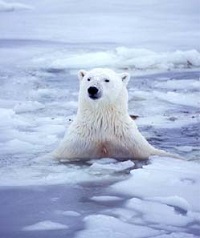 Polar bears are excellent swimmers. They have been known to swim more than 60 miles without a rest.
Polar bears are excellent swimmers. They have been known to swim more than 60 miles without a rest.
Wood frogs can be frozen solid and then thawed, and continue living. They use the glucose in their body to protect their vital organs while they are in a frozen state.
Axolotl and Squirrel Monkey
The axolotl of Mexico is a curious animal-a salamander like no other. Axolotls never grow up. Instead they remain in tadpole stage of development-complete with gills-all their lives and even breed as tadpoles.
Can you believe that some animals have five feet – four normal feet and a prehensile tail that is a tail that can curl around a support and grasp it? Some of these animals are the furry Kinkajou, the woolly opossum, the silky ant eater, the spider monkey and the tree porcupine.
Guinea pigs and rabbits don’t sweat. If we were like them the deodorant manufacturers would be out of business.
The female red billed hornbill takes precaution against intruders by building a wall across the opening of her nest. She then seals herself in and brings up her chicks in a ‘prison’.
Colugos are sometimes called flying lemurs, although they do not actually fly and they are not related to lemurs. Skilful climbers, colugos spend most of their time in trees. On the ground they are almost helpless.
Squirrel Monkey
Primates are mammals, which means they are warm-blooded, have fur, and feed their young milk. Primates have large brains which makes them among the most intelligent creatures on earth. They have excellent eyesight with both eyes facing forwards, which gives them good depth perception. Nearly all primates are good climbers, because they are very agile and can grasp with their hand and feet, The primates order is divided into three groups :monkey ,apes, and prosimians. There are over 233 species of primates, which include 158 monkeys,14 apes and 61 prosimians. They are also from the old world, and the majority of prosimians live on the island of Madagascar, off the coast of Africa.
Dinosaurs
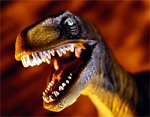 The earliest dinosaurs resembled two-legged, short-headed crocodiles, but later dinosaurs were oddly reminiscent of giant mammals and birds. It's easy to tell a dinosaur skeleton from that of a modern reptile because dinosaur skeletons have a strong joint between the backbones and hips. Small, two-legged dinosaurs could turn rapidly by swinging their tail abruptly in a direction opposite to where they wished to turn. Some dinosaurs had feathers.
The earliest dinosaurs resembled two-legged, short-headed crocodiles, but later dinosaurs were oddly reminiscent of giant mammals and birds. It's easy to tell a dinosaur skeleton from that of a modern reptile because dinosaur skeletons have a strong joint between the backbones and hips. Small, two-legged dinosaurs could turn rapidly by swinging their tail abruptly in a direction opposite to where they wished to turn. Some dinosaurs had feathers.
Some dinosaurs were as small as a hen, but the typical dinosaur weighed about as much as a hippopotamus or an elephant. Dinosaur eggs are smaller than those of modern birds. In fact, the largest known dinosaur eggs are much smaller than those of the extinct elephant bird of Madagascar.
Bats 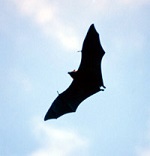 Not all bats are nocturnal – some are active during dawn and dusk. To get around in the dark and find their prey, many bats rely on a sophisticated form of sonar known as echolocation. Many bats, especially the crepuscular ones, have exceptionally good eyesight designed for low levels of light.
Not all bats are nocturnal – some are active during dawn and dusk. To get around in the dark and find their prey, many bats rely on a sophisticated form of sonar known as echolocation. Many bats, especially the crepuscular ones, have exceptionally good eyesight designed for low levels of light.
Camel: An annoyed camel will spit at a person.
The South American giant anteater eats more than 30,000 ants a day.
It is impossible to out-swim a shark - sharks reach speeds of 70 km/h (44 mph). Humans can run about 35 km/h (21 mph). The sailfish is the fastest swimmer, reaching 109 km/h (68 mph) The slowest fish is the Sea Horse, which moves along at about 0.016 km/h (0.01 mph).
Caterpillars - Gypsy caterpillars are known to wreak havoc. They have destroyed millions of acres of forests in the U.S.
The black Mamba can grow as much as 4 metres and can crawl at 19 kilometres per hour. In the last century 90% of orang-utans have disappeared. In the next ten they could be gone forever.
Believe it or not, stingrays are the most common cause of severe fish stings. They have whip-like tails that have sharp, sometimes barbed spines at the base. Through the spines, they can inflict severe wounds, injecting venom from poison glands. Stingrays are bottom-dwellers usually found in warm, shallow waters, so watch where you walk in the water.
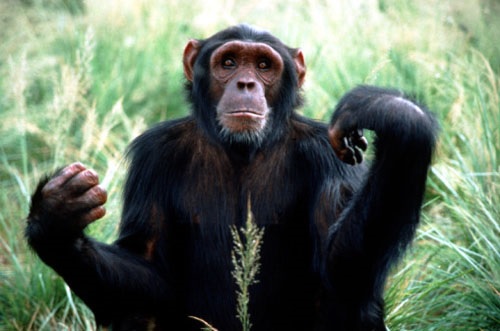
Probably the most intelligent non-human animal, chimpanzees are also very similar to us in appearance and in their social behavior. Chimpanzees sleep in nests they build in trees
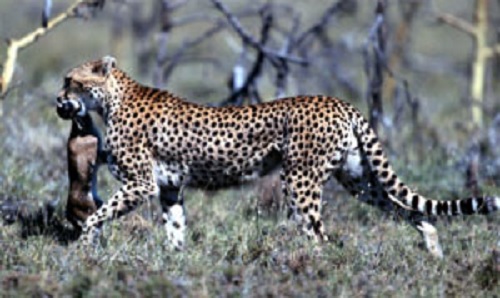
Cheetahs are the fastest animals on land. Reaching speeds of over 60 mph, they can easily outrun any animal over short distances.
Vampire bats are the only mammals that feed exclusively on blood. The three species are all found in Central and South America. Two feed almost entirely on bird blood, but the common vampire bat feeds on the blood of mammals.
Dolphins are believed by many people to be spiritual healers. Many people with illnesses swim with them in the hope that they might be cured and there is some evidence that it actually works!
The word 'octopus' means 'eight arms'. The arms are covered with several hundred suckers. Each one is sensitive to touch and taste and can be individually controlled to grip prey and anchor the octopus to rocks. Did you know that if an octopus loses an arm it can grow another one to replace it?
Just one cow gives off enough harmful methane gas in a single day to fill around 400 liter bottles. Cows can have regional accents.
A domestic cat can frighten a black bear to climb a tree.
In a fight between a polar bear and a lion, the polar bear would win.
Imagine this: a minnow-sized fish that can climb as high as five stories. That's what a kind of darter can do. It lives in some streams in eastern Brazil. Floods often flush the fish downstream. To make their way back home, they really have to work hard--especially when getting up waterfalls! Using their long, flat fins, they slowly inch themselves up the wet cliffs behind the waterfalls.
The Baya bird lights up its nest in an ingenious way. It captures a firefly and buries its head and thorax in the mud that lines the inside of the nest. Its abdomen continues to emit light, which lights up the interior.
When fighting, a kangaroo balances on its tail, grabs its rival with its forearms, and kicks with its hind legs.
The rattlesnake's rattle can be heard up to 50 km away.
Sperm whales can dive to a depth of 1000 metres (3281 ft).
In Native American stories coyotes are clever and tricky. This reputation is based on fact. Coyotes may scan the sky for ravens flying in circles. Coyotes know that the birds often hover over a dead animal, so finding the birds frequently leads to finding a free meal. Coyotes are clever enough to trick other animals. A coyote might leap about crazily near a group of birds to distract them, and then its partner might sneak up on the birds and seize a few of them for dinner.
The dorsal and pectoral fins of many species of catfish are edged with poisonous spines. The spines are used for defence and can inflict severe wounds. The poison arrow frog is only one of several amphibious species that secrete toxins from glands in its skin. The poison arrow frog uses its poison to kill potential predators.
Instead of chewing their food, some sauropods ground their food between stones in a portion of the digestive tract, much like the gizzard of a modern bird.
Raccoons love to come out of hiding at night – and they've a good reason to wait until morning to put your trash out on the curb. They have very nimble front paws – in fact, the word raccoon is a derivative of the Native American word arakun, which roughly means - he who scratches with his hands.
There are more dogs in the United States than there are people in the United Kingdom. There are more cats in the United States than there are people in France. Spayed female dogs live on average one and a half years longer than dogs not spayed. Dogs and cats are not furry people in disguise. They are wolves and North African wildcats in disguise.
Chocolate in excess is poisonous to dogs-the darker, the more dangerous. A single acetaminophen tablet can kill a cat. Never use human painkillers for cats except under veterinary supervision. Declawing cats is a cultural practice. It is sometimes done in North America, but it's almost unheard of in Europe.
When overpopulation of the Norway lemming leads to a food scarcity and habitat overcrowding, thousands of the animals migrate overland in search of food. Many lemmings die during the migratory process – lemmings that reach the sea drown while attempting to swim the ocean as if it were a river.
Ninety percent of all animal species that ever lived are now extinct.
Some insects may live for as long as a year, even when their heads are cut off.
Some fish like walking catfish, mudskippers and flying fish, can live on land.
Hippo phobia is not the fear of hippopotami; it is the fear of horses.
The basilisk lizard can, indeed, run across the surface of a body of still water, thus earning it the nickname Jesus Christ lizard. Basilisk lizards are found in tropical America from Mexico to Ecuador.
The bottle-nosed dolphin can detect sounds at frequencies more than seven times what a human can hear.
With a wing span of about 3 to 4 meters the albatross is the largest seabird.
Screech, Shivering and Great Horned are birds of the owl family.
A penguin can swim underwater by using its wings to propel itself like a torpedo.
Hawaiian monk seal is the only warm water seal.
The frigate bird soars over the sea but hardly lands on water.
The plover lays its eggs in a scrap on the ground.
Male Ibexes can have horns curved backwards as much as five feet and they may weigh twenty pounds.
Puffins dig burrows for themselves on the tops of cliffs. The female lays a single egg and the chick spends the first six weeks of its life underground.
In cold climates, some mammals, such as the European Dormouse, hibernate. They do not eat during this period-rather they live on fat stored in their bodies.
After several weeks of frequent feeding the adult bald eagles may starve and torment the young into hungry flight by showing them the fish and eating it.
The Coelacanth is a primitive bony fish of the Indian Ocean. It is a living fossil having been around for nearly 400 million years.
The hooded Pitohui is the only documented example of a poisonous bird. The feathers and skin of the hooded Pitohui contain a powerful neurotoxin which causes numbness and tingling skin in people.
Legend has it that sailors once mistakenly thought manatees were mermaids—hard to believe once you see one up close! Reaching up to 13 feet (4 meters) long and weighing as many as 1,300 pounds (600 kilograms), West Indian manatees look more like small cars than people. Despite their large size, manatees are graceful swimmers. Although they usually move along in slow motion, they can also cruise, or swim at a steady pace, at five miles (eight kilometers) an hour. In short bursts they can even top 15 miles (24 kilometers) an hour!
While cruising, manatees push themselves forward by moving their strong tails up and down. They steer with the help of their flexible flippers. When in shallow water, manatees use their flippers to walk, slowly placing one in front of the other.
Like whales and dolphins, manatees are mammals. Although they live in water, they have to surface frequently to breathe air. While swimming, manatees take in air every three or four minutes. When they are resting, they can stay underwater for up to 15 minutes.
Manatees are gentle animals. They rarely fight, and they have no natural enemies. But these animals—sometimes called sea cows—are often hurt by boats that travel through their waters. The slow-moving animals often can't get out of the way in time, and many have scars from propeller blades.
In the past, manatees have been hunted for their meat, hides, oil, and bones. Over the last hundred years, the number of manatees in the wild has decreased. Now laws are designed to help protect them.
Manatees subsist on water plants and plants that grow at the water's edge. They eat a lot—every day a manatee takes in up to 1 pound (0.5 kilogram) of food for every 10 pounds (5 kilograms) it weighs. If you weighed 80 pounds (36 kilograms), you would have to eat 8 pounds (4 kilograms) of salad a day to keep up with a manatee!
Eagles have no scruples. If they are unable to catch prey they might simply rob vultures or ospreys in mid air combat!
The largest of the South American, the seven foot Jaguar is a good swimmer and does much of its hunting in the water, sometimes capturing crocodiles.
Walruses have air sacs in their necks that enable them to keep their heads out of water when they sleep.
The giant African snail can weigh as much as 1 pound and is serious crop pest.
Whales breathe air. They are NOT fish .They are mammals that spend their entire lives in the water .The blue whale is the largest animal that has ever existed on earth. It is larger than any of the dinosaurs were .They are also the loudest animal on earth. Baleen whales (Mysticeti) - predators that sieve tiny crustaceans, small fish, and other tiny organisms from the water with baleen. Baleen is a comb-like structure that filters the baleen whale’s food from the water. Baleen whales are larger than the toothed whales and have 2 blowholes (nostrils). There are 10 species of baleen whales. Gray whales make the longest seasonal migration of the whales. They travel about 12,500 miles each year .Young cetaceans are frequently mottled in color, camouflaging them from predators. Newborns have spare covering of hair which they lose as adults.
An elephant can be pregnant for up to 2 years
Chickens can't swallow while they are upside down.
The average garden-variety caterpillar has 248 muscles in its head.
A goldfish has a memory span of 3 seconds.
More people are killed annually by donkeys than in airplane crashes.
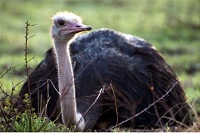 The largest bird egg in the world today is that of the ostrich. Ostrich eggs are from 6 to 8 inches long. Because of their size and the thickness of their shells, they take 40 minutes to hard-boil. The average adult male ostrich, the world's largest living bird, weighs up to 345 pounds.
The largest bird egg in the world today is that of the ostrich. Ostrich eggs are from 6 to 8 inches long. Because of their size and the thickness of their shells, they take 40 minutes to hard-boil. The average adult male ostrich, the world's largest living bird, weighs up to 345 pounds.
An ostrich's eye is bigger than its brain.
Ostrich eats pebbles to help digestion by grinding up the ingested food.
Butterflies taste with their feet.
There are more chickens than people in the world.
Most small lemurs (not the large ones) are nocturnal. In fact, the word lemur comes from the Latin lemur’s meaning "nocturnal spirits." These nocturnal insects have menacing pincers attached to the end of their abdomens. They received their name from the belief that they creep into people's ears. Perhaps at night, while people are sleeping?
Snails have 14175 teeth laid along 135 rows on their tongue
Kiwis are the only birds, which hunt by sense of smell.
A blind chameleon will still change color to match its surroundings
Ichneumon wasps are insects that could inspire a horror movie: it picks a victim, usually a caterpillar, and injects her eggs into the host's body. Often she also injects a poison that paralyzes the victim without killing it. Then, it eats the caterpillar but it keeps the victim alive as long as possible by eating its fatty deposits and digestive organs first and saving the heart and central nervous system for last.
14-Sep-2019
More by : Aniket Kumar